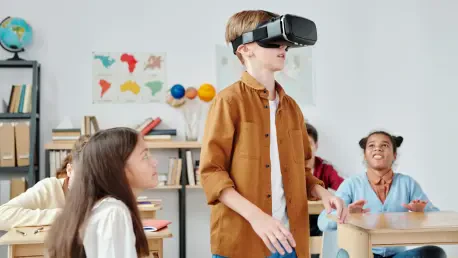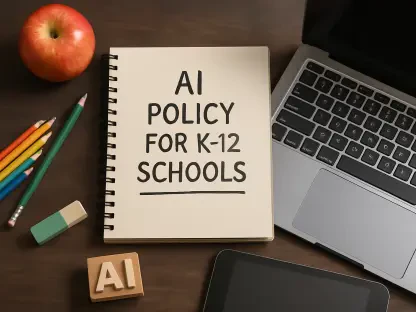Imagine a classroom where students dissect a virtual frog without ever picking up a scalpel, or explore ancient Roman ruins without leaving their desks—such is the power of Augmented Reality (AR) and Virtual Reality (VR) in transforming educational landscapes. These technologies are not just futuristic concepts but active tools reshaping how knowledge is delivered and absorbed in schools, universities, and training programs worldwide. By blending interactive, three-dimensional environments with traditional teaching methods, AR and VR create immersive learning experiences that captivate students and enhance comprehension. From virtual field trips to complex science simulations, these innovations cater to diverse learning styles and needs, breaking down barriers of access and engagement. As digital transformation accelerates across educational sectors, the integration of such cutting-edge tools signals a shift toward more dynamic, student-centered environments that prioritize experiential learning over rote memorization.
Transforming Classrooms with Immersive Technology
The adoption of AR and VR in education has surged, driven by a global push for digital learning solutions in K-12 schools, higher education, and corporate training. These technologies enable personalized experiences that adapt to individual student preferences, such as virtual labs where learners can experiment with chemical reactions in a risk-free setting. Subjects like STEM (Science, Technology, Engineering, and Math), history, and healthcare training benefit immensely, as complex concepts become tangible through interactive simulations. For instance, medical students can practice surgeries in a virtual operating room, gaining hands-on skills before stepping into real-world scenarios. Beyond improving retention, these tools foster a deeper understanding by allowing students to visualize abstract ideas in ways static textbooks never could. This shift toward experiential education also supports inclusivity, ensuring that students with different learning abilities can engage with content at their own pace.
Moreover, the impact of immersive technology extends to bridging geographical and socioeconomic gaps in education. Virtual field trips, for example, bring world-class museums or natural wonders to students who might never have the means to visit them in person. Language learners can practice conversational skills in simulated cultural settings, while vocational trainees hone practical abilities through realistic scenarios. The growing accessibility of VR headsets and AR-enabled mobile apps has made such experiences more feasible for institutions with varying budgets. Additionally, gamified content heightens student motivation, turning lessons into engaging challenges rather than mundane tasks. As governments and private sectors invest in digital infrastructure, particularly in regions like North America and Europe, the scalability of these solutions continues to expand, promising a future where quality education is not limited by physical or financial constraints.
The Technical Backbone of AR and VR in Learning
At the core of AR and VR educational tools are sophisticated technical components that create seamless, immersive experiences for users. Head-mounted displays (HMDs) provide fully interactive VR environments, while AR applications overlay digital information onto real-world settings through smartphones or tablets. Complementing these are 3D modeling software and content management platforms that allow educators to design customized lessons, from virtual historical reenactments to intricate engineering models. AI-driven learning engines further enhance this by tracking student engagement in real time and adapting content to suit individual progress. Such personalization ensures that each learner receives tailored support, maximizing educational outcomes. On the service front, providers offer teacher training, hardware integration, and performance analytics, enabling schools to implement these technologies effectively and scale their use across curricula.
Another critical aspect lies in the role of industry leaders who drive innovation through comprehensive ecosystems and partnerships. Companies have developed expansive content libraries and cloud-based delivery systems that simplify access to immersive resources for educators and students alike. For instance, platforms supporting virtual expeditions or mixed reality tools for STEM education have become integral in modern classrooms. These turnkey solutions reduce the technical burden on institutions, allowing them to focus on pedagogical goals rather than logistical challenges. As wearable devices become more affordable and user-friendly, the barrier to entry continues to lower, encouraging wider adoption. This technological foundation not only supports current educational needs but also paves the way for future advancements, ensuring that learning environments remain adaptable to emerging trends and student expectations over the coming years.
Driving the Future through Innovation and Investment
The momentum behind AR and VR in education is fueled by significant investments in digital infrastructure and educational technology (EdTech) worldwide. Governments in regions like Asia-Pacific are prioritizing funding to equip schools with the necessary tools, recognizing the potential of immersive learning to prepare students for a tech-driven economy. Private sector contributions, through strategic collaborations with academic institutions, further accelerate this growth by providing cutting-edge hardware and customized content. These partnerships ensure that curricula align with real-world applications, preparing learners for careers in fields that increasingly rely on digital proficiency. The rising demand for remote and hybrid learning solutions also plays a pivotal role, as AR and VR offer flexible, interactive alternatives to traditional classroom settings, catering to a global audience of diverse learners.
Beyond financial support, the cultural shift toward valuing experiential education has amplified the relevance of these technologies. Students today expect learning to be engaging and relevant, and immersive tools meet this demand by transforming passive lessons into active explorations. Whether it’s simulating historical events or conducting virtual experiments, the versatility of AR and VR applications showcases their potential to redefine educational standards. Continued focus on teacher training remains essential, ensuring educators are equipped to integrate these tools effectively into their teaching strategies. As analytics and AI refine the personalization of learning paths, the ability to address individual student needs becomes even more precise, fostering an environment where every learner can thrive. This ongoing commitment to innovation signals a robust trajectory for immersive technologies in shaping the next generation of education.
Reflecting on a Transformative Journey
Looking back, the integration of AR and VR into educational frameworks marked a pivotal shift in how knowledge was imparted and received. These technologies transcended traditional boundaries, offering students and educators alike a canvas of endless possibilities through virtual simulations and augmented experiences. The emphasis on engagement and inclusivity reshaped classrooms into spaces where learning was no longer a one-size-fits-all endeavor but a tailored journey for each individual. Investments in infrastructure and training played a crucial role in ensuring that such tools were not just novelties but sustainable solutions for modern education. Moving forward, the focus must remain on expanding access to these innovations, particularly in underserved regions, while refining content to meet evolving pedagogical needs. By fostering collaborations between technology providers and academic bodies, the path ahead can ensure that immersive learning continues to empower students globally, equipping them with skills for an ever-changing world.









